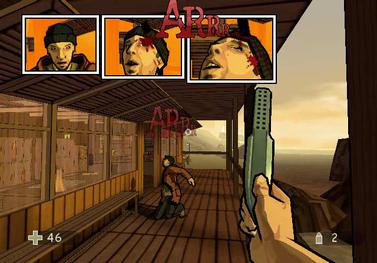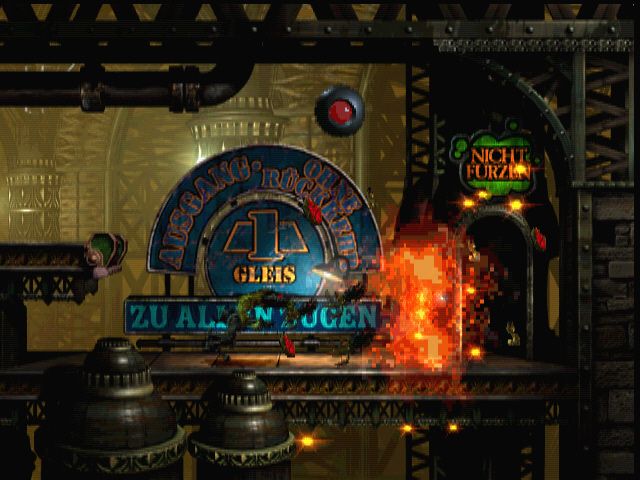Mind Factory Research Document - Gina
Summary of the purpose of this
document:
In "Mind Factory"
there will be two interactive windows, both in 3D. One will be focusing on "the
factory", the brain of the protagonist and all its functions. The other
window will be the world of the protagonist, seen through their eyes. In other
words; their vision. The second window, which can be referred to as "the
world", will be affected by
whatever the player does in "the factory". The player will have to
control and manage every part of the brain in order to complete simple tasks
the protagonist is trying to do in "the world". This research
document will be focusing on camera views and general art style, mainly of
"the world". Whatever is found during research that is relevant to
either of the two interactive windows will be included here. Anything that is
found during this research will hopefully be of interest to the other team
members of the group. Any general ideas that spring to mind will also be added
into this document for future reference.
General Concept / Camera:
1. Second Life
Second Life
is an online life simulator, basically a visual 3D chat room where you present
yourself as a customised 3D model to your liking. There are gameplay elements
like exploration and the collection of items (usually sold for real life
currency) but it is mainly just an impressive and massive virtual chat room.
The reason this is relevant to the project we are working on is because of two
things: the art style is appropriate for the "world" of the
protagonist, the general interaction with the world is a good source of
inspiration for our concept.
2. The Sims series
The Sims
series may not be exactly what the team was thinking of when the concept of
Mind Factory was introduced. The group already settled for 3D first person
view, but the game series is still relevant to this research since you can
control a character and its actions in life.
Mind
Factory is basically a life simulator with the mechanic of controlling the
brain which affects the protagonist's actions in a separated world, whereas the
Sims is a life simulator where the whole point of the game is to control their
actions by clicking objects and telling them what to do directly but without
going too in-depth. Still an inspiration for our concept and a similar art
style would be appropriate for any type of life simulator, including ours. The
style of this game would be better suited for the "world".
3. Live Action Videos
3a) Skyrim Live Action @ YouTube
This is a
very good example of a well done Live Action video, like CollegeHumor, it is
the same concept, except that this is based on/inspired by Skyrim and not real
life. If we were to do live action, and include a health bar, ammunition or
narrative, this would be the way to go about it for our concept.
I tried to
find an "appropriate" video of this but there aren't really any, but
to make a point I've included one of their videos below. College Humor POV is a
series of videos set in POV (point of view) of a college guy or girl, doing
everyday things in and outside college, all in Live Action. Something similar
would be good for our concept if we end up doing Live Action and not 3D, it's a
good inspiration if we were to do it in 3D as well, with the same camera style.
Video below:
Game play:
Window 1 (The Brain):
- Management of the crew, power balance and general strategy
- The point and click feature,
general management mechanic and general strategy
·
Strategic Drag and Drop (Tentacle
Wars, The Purple Menace) http://www.kongregate.com/games/gamezhero/tentacle-wars-the-purple-menace
Window 2 (The World):
·
Live Action (as shown in concept/camera
research)
·
Semi-Interactive 3D 1st person
camera
Think "Dear Esther", you
have some control but it's mostly an interactive film. Since the player will be
focusing on Window 1, the brain of the protagonist, there has to be a minimal
amount of control and interaction with the second window. There are two options,
having no control whatsoever of the second window as mentioned below, or small
amounts of limited interaction (perhaps just walking or clicking things, as you
do in Dear Esther).
·
Non-interactive cut scene based 3D
1st person camera
- A realistic 1st person camera view
through the protagonist's eyes, the character you control indirectly via the
strategic window next to it. For the camera view alone (and not gameplay), good
examples to have a look at are: Dark Messiah, Fallout and The Elder Scrolls
series, Amnesia/Penumbra series, Thief series, Call of Cthulhu: Dark Corners of
the Earth. Their cut scenes and general camera style would be perfect for the
second window of the UI.
More In-Depth Gameplay Research
1. Faster than Light
"In
Faster Than Light, the player controls a spacecraft and crew that intercepts a
data packet from a rebel fleet. The player's goal is to reach a Federation
fleet, which is waiting a long distance away, without being destroyed or caught
by the rebel fleet in pursuit."
The concept
of this game is very similar to Mind Factory, at least when it comes to the
factory window. The goal of Mind Factory is to manage and give orders to the
crew of the brain itself, that will make sure the brain functions as it should
and the player must balance out the power of the crew to make sure there's
enough workers in each part of the brain so the body of the protagonist
functions properly. The Dark Jester group also mentioned that the player may be
able to buy upgrades and such in order to improve performance and power of the
crew of the brain, which is exactly what you can do in Faster Than Light.
Source: http://www.ftlgame.com/
2. Civilizations Wars
Not as relevant as "Faster Than Light" but
a good example of a way we could handle all the mini-men in the brain. You
capture buildings and give orders to a small civilization by dragging them to
each building, which is basically what one would do in Mind Factory, just swap
the buildings with sections of the brain
that needs to be controlled by small groups of people. You learn skills and
defeat enemies along the way, which could be something we could implement into
our concept as well to make things a tad more interesting.
Art
style
Protagonist
window research
1. Comic book/cartoon
a) XIII
b) Outlaws
c) Team Fortress
d) The Sims
I did research on The Sims on page 2 of this
document where I explained why this is comparable to our concept, personally I
think the art style is the most appropriate for our concept as it's not too
serious and much more achievable in the time we have to make this game than
having realistic real-life graphics.
2. 1st person Pixel Art
8-bit Killer is a 1st person shooter in pixel art style.
b) Delver
Delver is
a 1st person pixel art dungeon crawler.
Brain Section Research:
Sources: http://www.oddworld.com/2010/08/abes-exoddus/ + http://www.oddworld.com/games-new-parent/abes-oddysee/


























